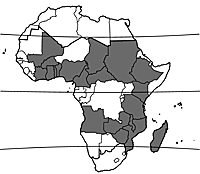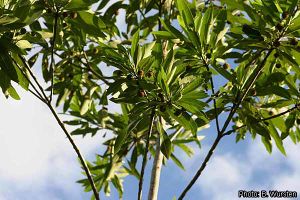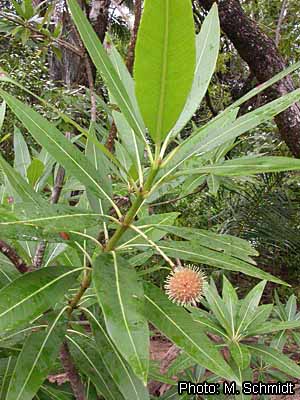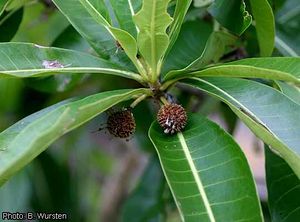Breonadia salicina (PROTA)
Introduction |
| General importance | |
| Geographic coverage Africa | |
| Geographic coverage World | |
| Vegetable oil | |
| Carbohydrate / starch | |
| Medicinal | |
| Timber | |
| Fuel | |
| Ornamental | |
| Auxiliary plant | |
| Fibre | |
Breonadia salicina (Vahl) Hepper & J.R.I.Wood
- Protologue: Kew Bull. 36(4): 860 (1982).
- Family: Rubiaceae
Synonyms
- Adina microcephala (Delile) Hiern (1877),
- Breonadia microcephala (Delile) Ridsdale (1975).
Vernacular names
- Water shea nut, African teak, wild oleander (En).
- Mgwina (Sw).
Origin and geographic distribution
Breonadia salicina is widely distributed in tropical Africa, from Côte d’Ivoire and Mali eastward to Ethiopia, and southward to Angola, Zimbabwe, Mozambique and Madagascar. It also occurs in South Africa, Swaziland and Yemen. It is sometimes planted.
Uses
The wood is suitable for heavy construction (including bridges), heavy flooring, joinery, mine props, boat building, vehicle bodies, furniture, sporting goods, toys, novelties, agricultural implements, railway sleepers, marine piles, carvings, pattern making and turnery. It is made into bows in Nigeria, for caskets in Madagascar, while in Malawi and Madagascar dugout canoes are made from the boles. In southern Tanzania the wood is extensively used as fuelwood.
The twigs are used for cleaning the teeth in West Africa. Breonadia salicina is often planted as an ornamental tree and sometimes also for erosion control and in windbreaks. The flowers serve as bee forage. In Madagascar the bark is added in the preparation of local alcoholic drinks (‘toaka gasy’) to help fermentation.
Breonadia salicina is widely used in traditional African medicine. Root decoctions are drunk as a purgative in Tanzania and against tachycardia in South Africa. An infusion of the pounded stem is given to breast-fed children in Ethiopia for the treatment of diarrhoea and vomiting. In Tanzania bark infusions are used for preventing influenza and for the treatment of stomach problems, and a decoction or infusion of the bark is used as a wash to clean wounds. Dried powdered bark is applied as a wound dressing. In Malawi the bark is chewed for the treatment of diarrhoea and stomach-ache, and a bark infusion is drunk for the treatment of pneumonia. In Madagascar a decoction of the inner bark is used as a mouthwash in case of cavities and abscesses. A leaf decoction is used in Nigeria as a bath for the treatment of yellow fever. In Malawi a leaf infusion is drunk to treat diarrhoea and stomach-ache. In Madagascar a leaf decoction is drunk for the treatment of malaria. In Ethiopia the seed is put into fire and the patient exposed to the smoke to treat joint pain. In veterinary medicine in Nigeria, the bark is used against diarrhoea. In Nigeria the root and bark are ingredients of arrow poisons on the basis of Strophanthus sarmentosus DC.
Properties
The heartwood may vary from yellowish to pale brown, pinkish brown, dark brown, dark grey or reddish, with brown or black markings; it is indistinctly or distinctly demarcated from the 2.5–5 cm wide sapwood. The grain is straight or wavy, texture fine and even. Freshly sawn wood has an oily feel and a characteristic smell, reminiscent of linseed oil.
The wood is heavy, with a density of 830–960 kg/m³ at 12% moisture content, strong and hard. It air dries well if dried slowly, but surface checking may occur. The rates of shrinkage are moderate, from green to oven dry 3.3–4.0% radial and 6.0–6.7% tangential. Reports on stability of the wood in service vary. At 12% moisture content, the modulus of rupture is 81–114 N/mm², modulus of elasticity 13,400–14,500 N/mm², compression parallel to grain 59–61 N/mm², compression perpendicular to grain 14 N/mm², shear 11.5–12 N/mm², Janka side hardness 8370–9790 N, Janka end hardness 7740–8770 N and Chalais-Meudon side hardness 6–9.
The wood is difficult to saw when green, but it saws fairly easily when dry. It works well with machine tools, but hand tools are subject to slip over due to oily surfaces. The wood is somewhat difficult to plane, but finishes and polishes well. It does not glue satisfactorily, but holds nails and screws well. It has good turning properties, but it is brittle in mortising. It has excellent weathering and wearing properties. The durability of the wood is high; it is resistant to fungi, termites and marine borers. The sapwood is resistant to Lyctus borers.
In studies in Swaziland, a 1:1 dichloromethane-methanol extract of the bark showed in-vitro antimalarial activity against Plasmodium falciparum, but no antibacterial activity against Escherichia coli. The extract did not show toxic effects on human red blood cells and kidney epithelial cells. In studies in South Africa, acetone, hexane, dichloromethane and methanol extracts of the bark showed antifungal activity against various fungi of plants or animals, but the extracts contained toxic compounds, limiting their usability. Breonadia salicina is reported to contain the alkaloid mitraphylline.
Description
- Evergreen, small to large tree up to 40 m tall; bole up to 150 cm in diameter, usually with slender branches near the base; bark surface longitudinally fissured, scaly, grey to grey-brown, inner bark fibrous, reddish, exuding a sticky sap; crown spreading, dense; twigs glabrous.
- Leaves usually arranged in whorls of (2–)3–5 at the ends of twigs, simple and entire; stipules interpetiolar, triangular, 4–6 mm long, bifid, fused at base, caducous; petiole 1–2.5 cm long; blade lanceolate to narrowly elliptical, 7–33 cm × 2–9 cm, cuneate at base, acute to slightly acuminate at apex, leathery, glabrous, pinnately veined with 16–25 pairs of lateral veins.
- Inflorescence an axillary, solitary, globose head 1.5–2.5 cm in diameter; peduncle up to 9.5 cm long, short-hairy, with 2–4 ovate bracts 0.5–1 cm long just above the middle.
- Flowers bisexual, regular, 5-merous, small, fragrant, sessile, with numerous 3–5 mm long bracteoles between the flowers; calyx with 1–2 mm long tube and oblong to linear or triangular lobes 1–2.5(–4.5) mm long; corolla 4–9 mm long, white, pinkish or yellowish, hairy outside, tube 3–6.5 mm long, lobes 1–2.5 mm long; stamens inserted in the corolla throat; ovary inferior, 2-celled, style 1–1.5 cm long, exserted, white, stigma ellipsoid or head-shaped, c. 0.5 mm long, green.
- Fruit an ellipsoid to obovoid capsule up to 5 mm long, densely clustered in a globose infructescence, hairy, dehiscent with 2 valves, few-seeded.
- Seeds obovoid, narrowly compressed, 2–3 mm long.
Other botanical information
Breonadia comprises a single species. It was formerly included in Adina, which is now restricted to Asia.
Anatomy
Wood-anatomical description (IAWA hardwood codes):
- Growth rings: 2: growth ring boundaries indistinct or absent.
- Vessels: 5: wood diffuse-porous; 9: vessels exclusively solitary (90% or more); 13: simple perforation plates; 22: intervessel pits alternate; 24: intervessel pits minute (≤ 4 μm); 29: vestured pits; 30: vessel-ray pits with distinct borders; similar to intervessel pits in size and shape throughout the ray cell; 41: mean tangential diameter of vessel lumina 50–100 μm; 42: mean tangential diameter of vessel lumina 100–200 μm; 47: 5–20 vessels per square millimetre; 48: 20–40 vessels per square millimetre.
- Tracheids and fibres: 62: fibres with distinctly bordered pits; 63: fibre pits common in both radial and tangential walls; 66: non-septate fibres present; 69: fibres thin- to thick-walled; 70: fibres very thick-walled.
- Axial parenchyma: 75: axial parenchyma absent or extremely rare; 78: axial parenchyma scanty paratracheal; 92: four (3–4) cells per parenchyma strand.
- Rays: 97: ray width 1–3 cells; 100: rays with multiseriate portion(s) as wide as uniseriate portions; 107: body ray cells procumbent with mostly 2–4 rows of upright and/or square marginal cells; 108: body ray cells procumbent with over 4 rows of upright and/or square marginal cells; 113: disjunctive ray parenchyma cell walls present; 116: ≥ 12 rays per mm.
Growth and development
Breonadia salicina grows fairly fast, at least 1 m per year in South Africa. In Benin trees flower in February–August, and fruits ripen in June–September. In southern Africa flowering is in November–March and fruiting in June–July.
Ecology
Breonadia salicina occurs from sea-level up to 1550 m altitude, usually in savanna regions but nearly always near rivers and streams, often in gallery forest, occasionally in rocky locations. In Madagascar it is found in dry deciduous forest as well as humid evergreen forest in areas with an average annual rainfall of 1000–2000 mm and 4–6 dry months, but always along rivers.
Propagation and planting
Breonadia salicina can be propagated from seed, but the germination rate is recorded to be low. More often, cuttings and wildings are used for planting. Cuttings are normally placed in mud. Seedlings are planted out from the nursery when they are at least 1 m tall.
Management
Breonadia salicina is prone to weed competition. Trees have been reported to coppice well. In Mozambique the minimum diameter allowed for felling is 50 cm.
Genetic resources
Breonadia salicina is widespread and locally common within its range. It is therefore unlikely to suffer from genetic erosion. In Malawi and South Africa, however, it is a protected species.
Prospects
Breonadia salicina is a multipurpose tree valued for its strong and durable timber and its medicinal uses. In view of its multipurpose character and fairly fast growth, its integration in agroforestry systems is recommended.
Major references
- Arbonnier, M., 2004. Trees, shrubs and lianas of West African dry zones. CIRAD, Margraf Publishers Gmbh, MNHN, Paris, France. 573 pp.
- Bekele-Tesemma, A., 2007. Useful trees and shrubs for Ethiopia: identification, propagation and management for 17 agroclimatic zones. Technical Manual No 6. RELMA in ICRAF Project, Nairobi, Kenya. 552 pp.
- Bolza, E. & Keating, W.G., 1972. African timbers: the properties, uses and characteristics of 700 species. Division of Building Research, CSIRO, Melbourne, Australia. 710 pp.
- Bridson, D. & Verdcourt, B., 2003. Rubiaceae (Cinchonoideae). In: Pope, G.V. (Editor). Flora Zambesiaca. Volume 5, part 3. Royal Botanic Gardens, Kew, Richmond, United Kingdom. 720 pp.
- Burkill, H.M., 1997. The useful plants of West Tropical Africa. 2nd Edition. Volume 4, Families M–R. Royal Botanic Gardens, Kew, Richmond, United Kingdom. 969 pp.
- Coates Palgrave, K., 2002. Trees of southern Africa. 3rd Edition. Struik Publishers, Cape Town, South Africa. 1212 pp.
- Keay, R.W.J., 1989. Trees of Nigeria. A revised version of Nigerian trees (1960, 1964) by Keay, R.W.J., Onochie, C.F.A. & Stanfield, D.P. Clarendon Press, Oxford, United Kingdom. 476 pp.
- Neuwinger, H.D., 1998. Afrikanische Arzneipflanzen und Jagdgifte. Chemie, Pharmakologie, Toxikologie. 2nd Edition. Wissenschaftliche Verlagsgesellschaft mbH, Stuttgart, Germany. 960 pp.
- Neuwinger, H.D., 2000. African traditional medicine: a dictionary of plant use and applications. Medpharm Scientific, Stuttgart, Germany. 589 pp.
- Takahashi, A., 1978. Compilation of data on the mechanical properties of foreign woods (part 3) Africa. Shimane University, Matsue, Japan. 248 pp.
Other references
- Akoègninou, A., van der Burg, W.J. & van der Maesen, L.J.G. (Editors), 2006. Flore analytique du Bénin. Backhuys Publishers, Leiden, Netherlands. 1034 pp.
- Blaser, J., Rajoelison, G., Tsiza, G., Rajemison, M., Rabevohitra, R., Randrianjafy, H., Razafindrianilana, N., Rakotovao, G. & Comtet, S., 1993. Choix des essences pour la sylviculture à Madagascar. Akon’ny Ala: Bulletin du Département des Eaux et Forêts 12–13. 166 pp.
- Bryce, J.M., 1967. The commercial timbers of Tanzania. Tanzania Forest Division, Utilisation Section, Moshi, Tanzania. 139 pp.
- Chhabra, S.C., Mahunnah, R.L.A. & Mshiu, E.N., 1991. Plants used in traditional medicine in eastern Tanzania. 5. Angiosperms (Passifloraceae to Sapindaceae). Journal of Ethnopharmacology 33: 143–157.
- Guéneau, P., Bedel, J. & Thiel, J., 1970–1975. Bois et essences malgaches. Centre Technique Forestier Tropical, Nogent-sur-Marne, France. 150 pp.
- Hepper, F.N. & Keay, R.W.J., 1963. Rubiaceae. In: Hepper, F.N. (Editor). Flora of West Tropical Africa. Volume 2. 2nd Edition. Crown Agents for Oversea Governments and Administrations, London, United Kingdom. pp. 104–223.
- Hines, D.A. & Eckman, K., 1993. Indigenous multipurpose trees for Tanzania: uses and economic benefits for people. FAO Forestry Paper, Rome, Italy.
- Johnson, D. & Johnson, S., 2002. Down to Earth: Gardening with indigenous trees. Struik Publishers, Cape Town, South Africa. 112 pp.
- Kaufmann, J.C. & Elvin Lewis, M., 1995. Towards a logic of ethnodentistry at Antongobe, southwestern Madagascar. Economic Botany 49(2): 213–222.
- Lovett, J.C., Ruffo, C.K., Gereau, R.E. & Taplin, J.R.D., 2007. Field Guide to the moist forest trees of Tanzania. Frontier Publishing, United Kingdom. 303 pp.
- Lutze, M., 2001. Aspekte des Holzmarktes und der holzbearbeitenden Industrie einiger ausgewählter Provinzen Mosambiks. PhD thesis. Wissenschaftszentrum Weihenstephan für Ernährung, Landnutzung und Umwelt, Technischen Universität München, Germany. 184 pp.
- Mahlo, S.M., 2009. Characterization and biological activity of antifungal compounds present in Breonadia salicina (Rubiaceae) leaves. [Internet] PhD thesis, University of Pretoria, Pretoria, South Africa. 120 pp. http://upetd.up.ac.za/thesis/available/etd-05222010–172550. November 2011.
- Maliwichi, C.P., 2000. A study of medicinal plants used for maternal and child diseases in Malawi: an ethnobotanical perspective. UNESCO, Paris, France. 64 pp.
- Maliwichi-Nyirenda, C.P. & Maliwichi, L.L., 2010. Medicinal plants used for contraception and pregnancy related cases in Malawi: a case study of Mulanje. Journal of Medicinal Plants Research 4(20): 2121–2127.
- Offiah, N.V., Makama, S., Elisha, I.L., Makoshi, M.S., Gotep, J.G., Dawurung, C.J., Oladipo, O.O., Lohlum, A.S. & Shamaki, D., 2011. Ethnobotanical survey of medicinal plants used in the treatment of animal diarrhoea in Plateau State, Nigeria. BMC Veterinary Research 7: 36.
- Palmer, E. & Pitman, N., 1972–1974. Trees of southern Africa, covering all known indigenous species in the Republic of South Africa, South-West Africa, Botswana, Lesotho and Swaziland. 3 volumes. Balkema, Cape Town, South Africa. 2235 pp.
- Sibandze, G.F. & van Zyl, R.L., 2009. The antimalarial and toxicity studies of Swazi medicinal plants. [Internet] Abstracts of the World Congress on Medicinal and Aromatic Plants, Cape Town, November 2008. African Journal of Traditional, Complementary and Alternative Medicines (special issue). http://journals.sfu.ca/africanem/index.php/ajtcam/article/view/895. November 2011.
- Sibandze, G.F., van Zyl, R.L. & van Vuuren, S.F., 2010. The anti-diarrhoeal properties of Breonadia salicina, Syzygium cordatum and Ozoroa sphaerocarpa when used in combination in Swazi traditional medicine. Journal of Ethnopharmacology 132: 506–511.
- Teferi Flatie, Teferi Gedif, Kaleab Asres & Tsige Gebre-Mariam, 2009. Ethnomedical survey of Berta ethnic group Assosa Zone, Benishangul-Gumuz regional state, mid-west Ethiopia. Journal of Ethnobiology and Ethnomedicine 5: 14.
- van Wyk, B.E. & Gericke, N., 2000. People’s plants: a guide to useful plants of southern Africa. Briza Publications, Pretoria, South Africa. 351 pp.
Sources of illustration
- Akoègninou, A., van der Burg, W.J. & van der Maesen, L.J.G. (Editors), 2006. Flore analytique du Bénin. Backhuys Publishers, Leiden, Netherlands. 1034 pp.
Author(s)
- E.E. Ewudzie, Forestry Research Institute of Ghana (FORIG), University P.O. Box 63, KNUST, Kumasi, Ghana
- J.R. Cobbinah, Forestry Research Institute of Ghana (FORIG), University P.O. Box 63, KNUST, Kumasi, Ghana
- S. Britwum Acquah, Forestry Research Institute of Ghana (FORIG), University P.O. Box 63, KNUST, Kumasi, Ghana
- E.A. Obeng, Forestry Research Institute of Ghana (FORIG), University P.O. Box 63, KNUST, Kumasi, Ghana
Correct citation of this article
Ewudzie, E.E., Cobbinah, J.R., Britwum Acquah, S. & Obeng, E.A., 2012. Breonadia salicina (Vahl) Hepper & J.R.I.Wood. [Internet] Record from PROTA4U. Lemmens, R.H.M.J., Louppe, D. & Oteng-Amoako, A.A. (Editors). PROTA (Plant Resources of Tropical Africa / Ressources végétales de l’Afrique tropicale), Wageningen, Netherlands. <http://www.prota4u.org/search.asp>.
Accessed 31 March 2025.
- See the Prota4U database.







